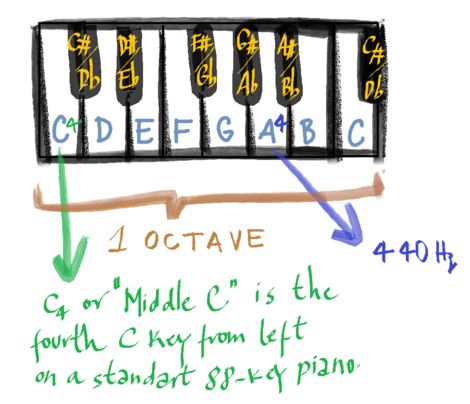WHAT IS MUSIC? Range, pitches and octaves.

The first question you might want to ask yourself is:

Sound is energy that moves as vibration through a medium (air, water, anything). Music and noise refer to how we perceive sound. The beauty we hear in music is somehow backed by how the sound is organized, and the oposite for noise, which is disorganized sound. Music is generally structured sound at every level (read this article from @gokulrmadas for an elaboration), and for some reason, humans have a tendency to be biased towards structure. That's just how it is.
I think there are two aspects to sound. The real and the imaginary.
The part of sound that is real is the part that makes the physical world vibrate, and the part that is imaginary is the part that makes our emotional world vibrate.
i.e., sound is not just sound, it contains within it meaning(s).

The next video is a very unique performance by John Cage that might change your perspective of music. This piece was actually written.
As musicians, one of the things we learn to do is listen and appreciate sonic art of all shapes and sizes.
Human Hearing Range and Musical Range
We can hear frequencies from around 20 Hz to 20,000 Hz. This changes from person to person, because our sensitivity to high and low frequencies is different. We can't actually hear all of these frequencies, but you can feel them in your stomach.
In music, we use the word range in different contexts. The range of a musical instrument is the distance from the lowest pitch to the highest pitch it can play. For a singer, we call it vocal range. The sounding range are the actual pitches that you can play with an instrument, and the written range are the notes you write on the musical score (they might or not be the same depending on the instrument). The difference between the quietest and loudest volume of an instrument or piece of music is called dynamic range.

Pitch is closely related to frequency, but they are not the same. The pitch is how you subjectively perceive a sound wave, which has a frequency that allows to measure it. In other words, pitch means how high or low a note is, and it is measured in Hertz.
Basically, a pitch is a sound with a frequency that is clear and stable enough to be able to distinguish. A note that is vibrating at 440 Hz will be caused by a sound wave that vibrates at 440 times a second. This is very useful and what makes possible a universal tuning system. A note on my piano in Chile and a note on my piano in Boston can be tuned exactly to the same frequency!
A440 or A4 (the 49th key on the standard piano), which has a frequency of 440 Hz, is the musical note A above middle C or C4, and it is used as a general standard for musical pitch. Because it is a definite pitch (clear and stable), we call it tone. A non pitch percussion instrument, like the snare drum, produces an indeterminate pitch.

An octave is the distance between two tones, where the first one has a Hertz number that is double the frequency of the other. For example, if we take A440 and double the frequency, we get a tone with 880 Hz. To our ears, this doubling of frequency is perceived as some sort of similarity. Human hearing range is like a spiral of 10 octaves, you hear repeating notes, except they don't really repeat.

In Western music, the octave has been divided into 12 definite pitches that are relatively at an equal distance. The letters A to G are assigned to seven of these pitches, and the notes that are an octave apart share the same letter to show the special relationship between their frequencies. The other five pitches are defined by adding the symbol # (sharp) to indicate a higher pitch and b (flat) to indicate a lower pitch. This creates an overlap that we in music we call enhamonics, in which a note is the same as another note, but spelled or named differently. For example, the pitch between the notes F and G can be written as "F-sharp" or "G-flat".
I hope this post will be helpful for the understanding of the very basics of sound. I tried to make it fun with drawings and as simple as possible. I plan on writing more in depth about this in the future and gradually going into more advanced subjects. Please let me know if there is something particular that you would like to learn! Thank you!
Mati :)

This is fantastic! Will you continue into a series? I love singing, dancing, and making music, but I lack any classical training, so I find the basics and terminology very valuable.
Hi! Thank you so much, there is more to come. Would you like me to talk about anything in particular?
Oh it's the basics really for me... I have a natural ability but no proper training...
Congratulations! This post has been upvoted from the communal account, @minnowsupport, by aurealistic from the Minnow Support Project. It's a witness project run by aggroed, ausbitbank, teamsteem, theprophet0, and someguy123. The goal is to help Steemit grow by supporting Minnows and creating a social network. Please find us in the Peace, Abundance, and Liberty Network (PALnet) Discord Channel. It's a completely public and open space to all members of the Steemit community who voluntarily choose to be there.
If you like what we're doing please upvote this comment so we can continue to build the community account that's supporting all members.
What about rap?
Hi! Thanks for reading! Do you mean if I consider rap to me music? It's a vocal technique, and an important part of hip-hop music, so yes! I am familiar with rap only till a certain extent, but I've heard some rap artists and their message is always strong. Music is a form of expressing and communicating, and so is rap. I hope I answered your question!